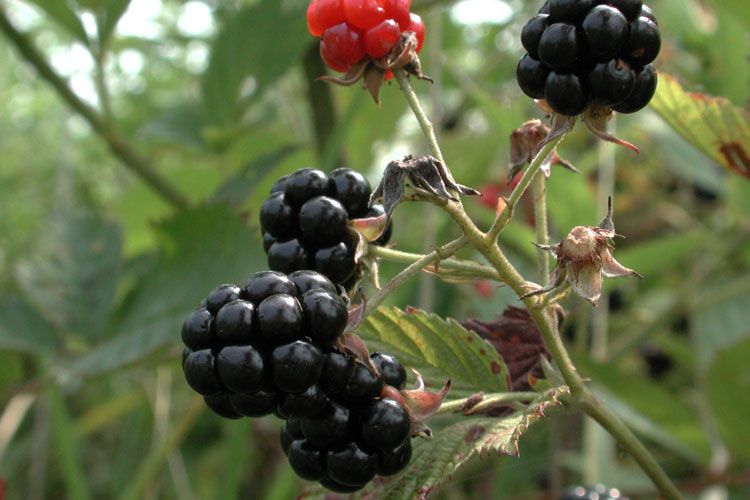

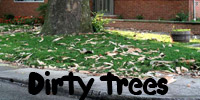
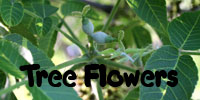

(Additional content at flickr Photostream and YouTube Channel) If you have botany questions or comments please email BobK . Thanks!
June 24, 2010. Caledonia, Marion County, Ohio.
Today I saw this pretty little flower, with bilaterally symmetric flowers of separate petals, one of which is much larger than the others. It is obviously a legume of some sort. It was rather abundant in a field.

Lovely little legume in a field in Caledonia, Marion County, Ohio. June 24, 2010.
Here's the field it was
growing in.

The field it was growing in. June 24, 2010. Caledonia, Marion County, Ohio.
O.K. ha ha. It's just a soybean field. You knew that, didn't you? But I'd never looked closely at a soybean plant before, at least not in flower. In fruit, they're a lot more distinctive, as seen during October a few years back.

Soybean fruits. October 10, 2008. Caledonia, Marion County, Ohio.

The field it was growing in. June 24, 2010. Caledonia, Marion County, Ohio.
O.K. ha ha. It's just a soybean field. You knew that, didn't you? But I'd never looked closely at a soybean plant before, at least not in flower. In fruit, they're a lot more distinctive, as seen during October a few years back.

Soybean fruits. October 10, 2008. Caledonia, Marion County, Ohio.
...and the field these were
growing in:

Autumn soybeans. October 10, 2010. Caledonia, Marion County, Ohio.

Autumn soybeans. October 10, 2010. Caledonia, Marion County, Ohio.
The
soybean is a very ancient "cultigen," i.e., a plant that has been
deliberately altered through artificial selection. It originated from a
wild Asian species, Glycine soja.
Although soybeans are high in protein and glycine is the name of
an amino acid (the building blocks of proteins), the generic name
"glycine" is actually derived from a Greek work meaning "sweet."
However, the
sweet thing that prompted Linneaus to come up with that crazy name was
actually the tuber of a wholly different legume --a North American vine
now known as Apios americana
(groundnut), which he originally classified as Glycine apios.
At the nearby Claridon Railroad Prairie, another legume is in flower. This one is the extremely wild, extremely beautiful and, at times, extremely annoying showy tick-trefoil, Desmodium canadense.

Showy tick-trefoil in Caledonia, Marion County, Ohio. June 24, 2010.
Tick-trefoils are often annoying because their fruits have tiny little hooked bristles on their flat sides, and this causes them to adhere to clothing. Here's a picture of showy tick-trefoil taken in September a few years back. The tick-trefoil fruit is a slight variant of the a several-seeded legume fruit that is called a "loment." A loment breaks apart at constrictions between the seeds and disperses as annoying one-seeded units.
Showy tick-trefoil at the OSU-Marion Prairie.
September 16, 2006.
At the nearby Claridon Railroad Prairie, another legume is in flower. This one is the extremely wild, extremely beautiful and, at times, extremely annoying showy tick-trefoil, Desmodium canadense.

Showy tick-trefoil in Caledonia, Marion County, Ohio. June 24, 2010.
Tick-trefoils are often annoying because their fruits have tiny little hooked bristles on their flat sides, and this causes them to adhere to clothing. Here's a picture of showy tick-trefoil taken in September a few years back. The tick-trefoil fruit is a slight variant of the a several-seeded legume fruit that is called a "loment." A loment breaks apart at constrictions between the seeds and disperses as annoying one-seeded units.

Showy tick-trefoil at the OSU-Marion Prairie.
September 16, 2006.
June 22 and 25, 2010. Wyandot County, Ohio.
Climbing prairie rose, Rosa setigera,
in Rosaceae, the (surprise!) rose family, is a beautiful native shrub.
It's our only native rose that has its styles united into a column
protruding from the orifice of the hypanthium (i.e., "floral cup,"
consisting of the fused bases of the sepals, petals and stamens). This
style-column extends above the very numerous and spirally arranged
stamens.

Climbing prairie rose styles are united into a column. June 22, 2010. Wyandot County, Ohio.

Climbing prairie rose styles are united into a column. June 22, 2010. Wyandot County, Ohio.
The style column is
positioned in the flight-path of approaching pollen-gathering bees. In
the following video, note first a non-pollinating fly of some sort,
apparently finding something nutritious on the petals that it is
gathering with its weird sponging-sucking mouthparts. In the exciting
finale,
see how a "pollen bee" lands by grabbing on the stigma-column, no doubt
effecting
pollination of the rose.
Fly and bee on rose blossom.
June 22, 2010. Wyandot County, Ohio.
The pollen-gathering
hymenopteran is a
"sweat bee," i.e., a member of the family Halictidae. Sweat bees,
depending upon the species, may be solitary or, more frequently,
"semisocial," wherein daughters stay with their mother and help her
rear more daughters. Halictids nests are located in burrows in soil or
decaying wood. Based solely on picture matching on this great web site,
this here seems maybe to be Augochlora
pura.
Note how she extracts pollen, by bundling together a bunch of stamens and buzzing. The vibrations evidently break grains loose from the anthers. Indeed, a phenomenon called "buzz pollination" is a well-known mechanism seen in a few quite specialized flowers, such as those of tomato and nightshade, that have tubular anthers pointing downward and opening by terminal pores. But buzzing to extract pollen from rather typical anthers, let's call it semibuzz pollination, is something I've never heard of. Is it well known? Given the high amount of visitation to these rose blossoms, not only by bees but also by pollen-consuming beetles (see below), there's probably just a few stubborn pollen grains left left in the anthers, and the buzzing seems urgently needed in order like to squeeze them out.
Note how she extracts pollen, by bundling together a bunch of stamens and buzzing. The vibrations evidently break grains loose from the anthers. Indeed, a phenomenon called "buzz pollination" is a well-known mechanism seen in a few quite specialized flowers, such as those of tomato and nightshade, that have tubular anthers pointing downward and opening by terminal pores. But buzzing to extract pollen from rather typical anthers, let's call it semibuzz pollination, is something I've never heard of. Is it well known? Given the high amount of visitation to these rose blossoms, not only by bees but also by pollen-consuming beetles (see below), there's probably just a few stubborn pollen grains left left in the anthers, and the buzzing seems urgently needed in order like to squeeze them out.
Augochlora
pura buzzes off pollen!
Meanwhile, members of a
different insect order --Coleoptera (beetles) --visit the flowers to
acquire pollen. Prominent on the prairie rose is a type of flower
longhorn beetle (family Cerambycidae, subfamily Lepturinae) that almost
but not quite picture-matches
to Typocerus
acuticauda. The sharp-pointed rear edge of the elytra (hardeneed
front wings, the hallmark of the coleopterans) seem
suggestive of that species.

Flower longhorn beetle on prairie rose. June 22, 2010. Wyandot County, Ohio.

Flower longhorn beetle on prairie rose. June 22, 2010. Wyandot County, Ohio.
Flower
longhorns are long and narrow, distinctively tapering from
broad-"shoulders." Larvae develop in the decaying wood. The adults are
active in the
daytime, visiting flowers to feed on pollen. Here's a still image of
one doing that.

Flower longhorn --Typocerus acutcauda perhaps? --on rose blossom, eating pollen.

Flower longhorn --Typocerus acutcauda perhaps? --on rose blossom, eating pollen.
...and
here are 6,660 more images of the same beetle, displayed in rapid
succession. The pictures sort of blend together, giving an odd
sensation of motion (a curious illusion, probably without any
commercial value).
Flower longhorn feasts on
rose pollen. June 22, 2010. Wyandot County, Ohio.
An Aggregate of Drupelets
Raspberry Fruits (and a flowery flashback)
June 21, 2010. Caledonia, Marion Couny, Ohio.
It's fun to observe the same
plant at different stages of development, particularly when at one time
it's flowering and then later it's in fruit. Today I stopped by
Terradise Nature Preserve in Caledonia, Marion County, Ohio to
re-visit a particular black raspberry shrub (Rubus occidentalis, family
Rosaceae, the rose family).

Black raspberry fruits are aggregates of drupelets. June 21, 2010. Marion County, Ohio.

Black raspberry fruits are aggregates of drupelets. June 21, 2010. Marion County, Ohio.
Forty-two days earlier the
shrub was in flower.
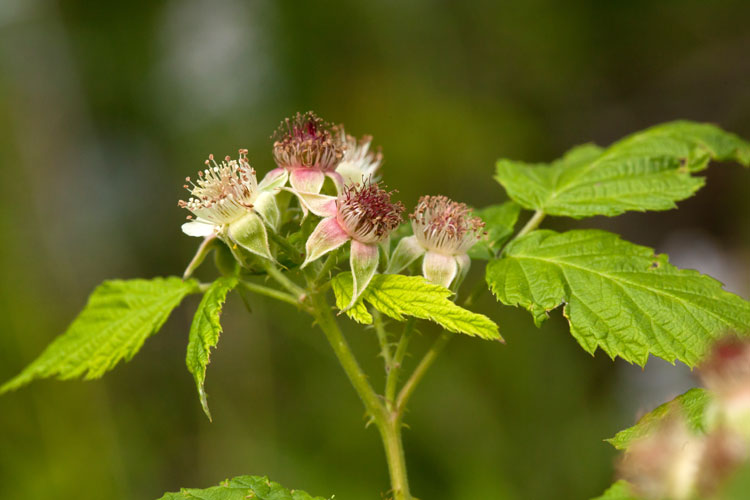 Raspberry
flowers are 5-merous, with numerous stamens
and pistils.
Raspberry
flowers are 5-merous, with numerous stamens
and pistils.
May 10, 2010. Marion County, Ohio.
 Raspberry
flowers are 5-merous, with numerous stamens
and pistils.
Raspberry
flowers are 5-merous, with numerous stamens
and pistils.May 10, 2010. Marion County, Ohio.
The raspberry flower displays
well the features of the family Rosaceae, or at least its biggest
subfamily, the Rosoideae. Note the perfect (bisexual) radially
symmetric flowers with 5 separate sepals, 5 petals, many spirally
arranged stamens, and many spirally arranged carpels set atop a
dome-shaped receptacle. The flower eventually matures into an aggregate
fruit, i.e., one largish fruit-like thingabobbie that is in fact many
small subunit fruits packed tightly together, wherein the members of
the bunch are each derived from separate carpels of the same individual
flower. Here's a close-up of the raspberry flower.
 Raspberry
stamens and carpels are numerous, and
spirally arranged.
Raspberry
stamens and carpels are numerous, and
spirally arranged.
May 10, 2010. Marion County, Ohio.
 Raspberry
stamens and carpels are numerous, and
spirally arranged.
Raspberry
stamens and carpels are numerous, and
spirally arranged. May 10, 2010. Marion County, Ohio.
The genus Rubus comprises both raspberries
and blackberries. Both are aggregate fruits wherein the small subunits
are "drupelets," i.e., miniature versions of what cherries, peaches,
and apricots are: drupes. Raspberries are distinguished from
blackberries by the manner in which the aggregate fruit detaches from
the plant. When a raspberry is picked, it separates from the
receptacle, which is persistent on the pedicel.
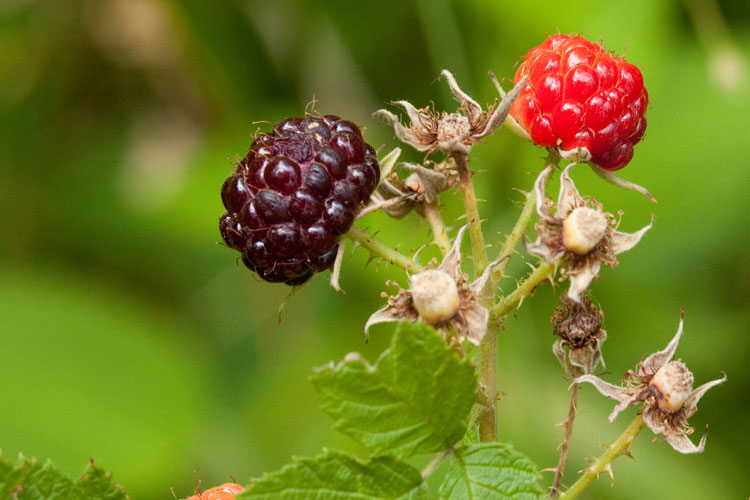
A raspberry wholly separates from the receptacle. Notice its stumpy remnant.
June 21, 2010. Marion County, Ohio.
MOUSEOVER
the IMAGE to "PICK" the FRUIT

A raspberry wholly separates from the receptacle. Notice its stumpy remnant.
June 21, 2010. Marion County, Ohio.
A blackberry is very similar
to a raspberry. Here's one, common blackberry, Rubus allegheniensis, seen a few
years ago at the Larry R. Yoder Prairie at OSU-Marion.


Blackberry flowers are
5-merous, with numerous stamens and pistils.
June 3, 2005. Marion County, Ohio.
June 3, 2005. Marion County, Ohio.
A blackberry flower in
cross-section displays well the Rosaceae, subfamily Rosoideae, floral
details enumerated above. Moreover this view shows another Rosaceae
feature --the one that differentiates roses from buttercups
(family Ranunculaceae) -- the presence of a small but distinct
hypanthium, or
"floral cup," consisting of the fused bases of the sepals, petals and
stamens.
A Wallflower (not the wallflower).
Kenilworth-ivy (Cymbalaria muralis)
June 20, 2010. Columbus, Ohio.
A little vine sometimes seen
as a weed in greenhouses is also occasionally encountered out-of-doors.
This is ivy-leaved toadflax, also called "Kenilworth ivy," a native of
Mediterranean Europe in the toadflax family, Scrophulariaceae. The
specific epithet "muralis" means "wall," so this might rightly be
called "wallflower," but that common name is already taken, by some
plants in the mustard family (several Erysimum
species). But true to its non-name, Kenilworth-ivy is merrily
growing on a stone wall along a little embayment of the Scioto River in
Columbus.
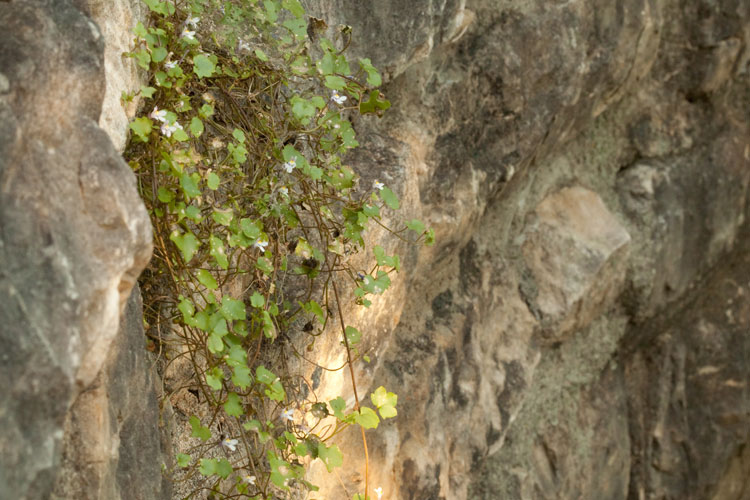
A stone wall with Kenilworth-ivy on it. June 20, 2010. Columbus, Ohio.

A stone wall with Kenilworth-ivy on it. June 20, 2010. Columbus, Ohio.
The flowers of Cymbalaria
are typical of a subset of the Scrophulariaceae (in the traditional
sense): snapdragon-like blossoms that are 5-merous. zygomorphic, with a
spurred corolla, and 4 stamens (not visible in these photos). This
pretty little plant is sometimes cultivated (apparently less commonly
nowadays than in the past) in shady rocky areas.

Kenilworth-ivy flower is snapdragon-like, with a spurred corolla.

Kenilworth-ivy flower is snapdragon-like, with a spurred corolla.
A Leather Fungus, Perhaps.
Theleophora palmata (?)
June 19, 2010. Henry County, Ohio (for sure).
During the afternoon, the
OMLA foray to Henry County landed at one of the few remaining wooded
areas in this predominantly agricultural area, part of the Maumee
State Forest. There a non-lichenized but nonetheless intriguing fungus
stands atop a mossy log. (Atrichum
angustatum
is the moss.) It looks like a little grove of model railroad trees. The
fungus has a leathery texture and a quick look under micrsoscope at
400X showed basidia, so this is likely one of the so-called "leather
fungi" in the family Thelephoraceae. There are no spot-on matches with
any of the books I have, or on the web, but Thelephora palmata seems like a
reasonable guess.

Thelephora palmata (?) with Atrichum angustatum moss on log. June 19, 2010. Henry County, Ohio.
Nearby, a large stand of a robust fern, bracken, Pteridium aquilinum (Dennstaedtiaceae). Bracken is often found in recently burned-over areas, although it doesn't seem like this area has had any fires recently. Bracken is an especially wide-ranging fern that historically has had many uses as food and medicine, but also has been shown to be carcinogenic, so it's best to avoid eating the stuff.

Bracken fern, June 19, 2010. Henry County, Ohio.

Lichen-covered tree stump. June 19, 2010. Henry County, Ohio.
Closeup it was apparent that this is a fruticose (shrubby) lichen in the genus Cladonia. Most of the light gray covering the stump consists of the lichen's primary squamules, that resemble a foliose (leafy) lichen. These squamules are very small and finely lobed. Delightfully, there are abundant short upright podetia topped with dark brown spores bearing structures called "apothecia." In other words, this is a perfect specimen for a definitive ID. Chemical spots tests --no reaction with 10% KOH (potassium hydroxide), but quickly turning red upon the application of "P" (paraphenylenediamine) --proved this lichen to be "stubby-staked cladonia," Cladonia caespiticia, an eastern U.S. species that is widespread in eastern and southern Ohio, with this a new recond for the county (yippee!). It is said to be common on bark, rotting logs, soil and moss.

Stubby-stalked cladonia on a stump in Henry County, Ohio. June 19, 2010.
Another lichen in the vicinity, this one insanely common, is a foliose one on tree trunks that is large and gray, with abundant "isidia" (small cylindrical outgrowths on the surface). It's rough speckled shield lichen, Punctelia rudecta.

Rouch specked shield lichen at Henry County, Ohio. June 19, 2010.
A few miles away we went to an open area traversed by a trail entertainingly named the "Wabash Cannonball Trail."

Wabash Cannonball Trail. Henry County, Ohio. June 19, 2010.
There weren't many mosses or lichens there, but there was, as if to make up for the evil buckthorn in its family, a decidely non-invasive native member of the Rhamnaceae. This is New Jersey tea, Ceanothus americanus.

New Jersey tea. Henry County, Ohio. June 19, 2010.
New Jersey tea is a low shrub of open areas. Being fire-tolerant, it is a known as a prairie plant. It a larval food source for the mottled dusky-wing and spring azure butterflies, and is a nectar source for many butterflies.

New Jersey tea. June 19, 2010. Henry County, Ohio.

Thelephora palmata (?) with Atrichum angustatum moss on log. June 19, 2010. Henry County, Ohio.
Nearby, a large stand of a robust fern, bracken, Pteridium aquilinum (Dennstaedtiaceae). Bracken is often found in recently burned-over areas, although it doesn't seem like this area has had any fires recently. Bracken is an especially wide-ranging fern that historically has had many uses as food and medicine, but also has been shown to be carcinogenic, so it's best to avoid eating the stuff.

Bracken fern, June 19, 2010. Henry County, Ohio.
At the edge of the woods it
was a pleasure to see a tree stump coated with a lichen. From a
distance it appears uniformly gray with a brownish cast over part of it.

Lichen-covered tree stump. June 19, 2010. Henry County, Ohio.
Closeup it was apparent that this is a fruticose (shrubby) lichen in the genus Cladonia. Most of the light gray covering the stump consists of the lichen's primary squamules, that resemble a foliose (leafy) lichen. These squamules are very small and finely lobed. Delightfully, there are abundant short upright podetia topped with dark brown spores bearing structures called "apothecia." In other words, this is a perfect specimen for a definitive ID. Chemical spots tests --no reaction with 10% KOH (potassium hydroxide), but quickly turning red upon the application of "P" (paraphenylenediamine) --proved this lichen to be "stubby-staked cladonia," Cladonia caespiticia, an eastern U.S. species that is widespread in eastern and southern Ohio, with this a new recond for the county (yippee!). It is said to be common on bark, rotting logs, soil and moss.

Stubby-stalked cladonia on a stump in Henry County, Ohio. June 19, 2010.
Another lichen in the vicinity, this one insanely common, is a foliose one on tree trunks that is large and gray, with abundant "isidia" (small cylindrical outgrowths on the surface). It's rough speckled shield lichen, Punctelia rudecta.

Rouch specked shield lichen at Henry County, Ohio. June 19, 2010.
A few miles away we went to an open area traversed by a trail entertainingly named the "Wabash Cannonball Trail."

Wabash Cannonball Trail. Henry County, Ohio. June 19, 2010.
There weren't many mosses or lichens there, but there was, as if to make up for the evil buckthorn in its family, a decidely non-invasive native member of the Rhamnaceae. This is New Jersey tea, Ceanothus americanus.

New Jersey tea. Henry County, Ohio. June 19, 2010.
New Jersey tea is a low shrub of open areas. Being fire-tolerant, it is a known as a prairie plant. It a larval food source for the mottled dusky-wing and spring azure butterflies, and is a nectar source for many butterflies.

New Jersey tea. June 19, 2010. Henry County, Ohio.
Also present along the trail
in this wide open area is a dogbane less frequently seen than Indian
hemp. This special one is spreading dogbane, Apocynum androsaemifolium
(Apocyanceae). It's larger and bushier than A. cannabinum and the flowers are
more open, with reflexed corolla lobes and pretty pink striping within.

Spreading dogbane. Henry County, Ohio. June 19, 2010.

Spreading dogbane. Henry County, Ohio. June 19, 2010.
Large Twayblade
June 19, 2010. Henry County, Ohio.
Thanks to "Facebook," I now know what a muck farm is. Not, as I had suspected, a place they grow muck, but instead a farm for celery, lettuce, and other "wet" crops. They have them in Celeryville, Ohio. Yay!
In the dense thicket of evil buckthorn at the abandoned muck farm that OMLA visited this morning seeking cryptogams, there's a small population of an orchid called large twayblade, Liparis lilifolia. Orchids are annoying, in part because, while they're so rare and local you'd be Public Enemy Number One for yanking one out of the ground, orchid flower structure is so different from that of other plants that close examination, best achieved by yanking one out of the ground, is required in order to figure out what's what.

Large twayblade. June 19, 2010. Henry County, Ohio.
There is a detailed description in E. Lucy Braun's "The Monocotyledonae" (of Ohio; 1967, OSU Press). E. tells us that orchid flowers are "...zygomorphic (bilaterally symmetrical); sepals 3 (or 2 by fusion), the lateral often differentiated from uppper; petals 3, the lateral similar (in species-text referrred to as petals), the third highly modified and called the lip (labellum) often larger and different in color from others and extended at base into a spur..."
Here's a "zoom crop" of one flower in the picture above on which several of the features cited by E. are evident. Note, by the way, that the Liparis labellum has no spur. Also, although it is not evident in this photo (but it is on the next), there are indeed two lower sepals, and not one by fusion; the narrow sepals are simply close together and parallel.
MOUSEOVER
the IMAGE for LABELS

Orchid flowers are upside-down!!
E. goes on to tell us that the flower has "ovary inferior, of 3 carpels but unilocular, it or the pedicel usually twisted 180 degrees, causing the dorsal to become (in position) the upper sepal and the lip to be downward, the flower thus resupinate (turned upside down)..." Orchid flowers are upside down! The lower petal is actually the upper one. and the upper sepal is actually the lower sepal!! There seems to be a little suggestion of an oblique longitudinal fissure or ridge, evidence of torsion during development, in the ovary on the photo above. Maybe?
Orchids, in an admirable but futile attempt to become milkweeds, have a compound structure in the middle of their flower, and they also disperse their pollen not as separate individual grains, but all together as waxy masses called "pollinia." E. puts it this way: "...style, stigmas, and stamens (1 or 2) are united and form a central "column"; if one stamen then anther terminal on column, if two then lateral on column [Note: in Liparis there is one stamen, terminal on column.]; stigma low on anterior face of column; pollen coherent in granular or waxy masses, pollinia, in each locule of anther..." Some of these feature can be discerned in the image below.
MOUSEOVER
the IMAGE for LABELED
ZOOM-CROP
Muck Farm
June 19, 2010. Henry County, Ohio.
I'm not sure exactly what a muck farm is, but about a dozen intrepid Ohio Moss and Lichen Association members went to one on their annual Summer Foray, this year to Henry County in northeastern Ohio.

Abandoned Much farm in Henry County. June 19m 2010.
The soil seems to be an
interesting misture of wet, calcareous, organic, and sandy, a quite
unique habitat that is home to some intruguing vascular plants with a
fidelity to such areas. Here's one of them, Kalm's St. Johnswor Hypericum kalmianum (Clusiaceae) a
remarkably large-flowered member of the genus, and one our very few
woody Hypericum species.

Kalm's St. Johnswort. June 19, 2010. Henrey County, Ohio.

Kalm's St. Johnswort. June 19, 2010. Henrey County, Ohio.
The Clusiaceae (formerly
Hypericaceae, and Guttiferae) is a large and variable family that
consists mainly of tropical trees and shrubs. We have only two genera
in our region, of which Hypericum
(St. John's-wort) is by more common and speciose. These are
opposite-leaved plants with flowers that are yellow and, except for one
4-merous oddball (St. Andrew's cross, H.
hypericoides, that used to be in a separate genus, Ascyrum)
5-merous. The stamens are typically very numerous, giving the flowers a
nice fluffy brushy look.
Here's a closer look at the flower.

Kalm's St. John's-wort flower. June 19, 2010. Henry County, Ohio.
Here's a closer look at the flower.

Kalm's St. John's-wort flower. June 19, 2010. Henry County, Ohio.
Another unusual plant that is
found either in moist or dry, usually sandy soil is colic-root, Aletris farinosa
(Liliaceae). The tepals (petals and sepals, considered together
because they are so similar) are roughened with short scale-like
points, giving the flowers a mealy ("farinose") appearance. The genus
name is from the Greek. (Why do they always say "the
Greek"? Is that any different from just "Greek?") Aletris is a
word that means a female slave who grinds corn, also in
allusion to the mealy flowers. (I don't think it's actually her name,
but just what she is. Sorry, aletris, not only do you have a lousy job,
but you don't even have the pretty name "Aletris."

Colic-root flowers. June 19, 2010. Henry Couny, Ohio

Colic-root flowers. June 19, 2010. Henry Couny, Ohio
A strikingly beautiful little
annual herb, albeit one that is not especially rare, is field milkwort,
Polygala sanguinea
(Polygalaceae, the milkwort family). These plants produce numerous
small flowers that are presented in a dense head-like raceme. The most
conspicuous parts of the flowers are two sepals that are enlarged and
petaloid and, in the photo below, are obscuring the other flower parts:
3 smaller sepals, and 3 small petals fused to a column of stamens, and
a pistil that matures into a small capsule.

Field milkwort at the muck farm. June 19, 2010. Henry County, Ohio.

Field milkwort at the muck farm. June 19, 2010. Henry County, Ohio.
Meadow sundrops, Oenothera pilosella,
is a nifty little wildflower. It's in the evening-primrose family
(Onagraceae), and a member of a genus that indeed includes some
night-blooming, moth-pollinated members. However, this is
strictly a daytime one. Having 4 petals, sundrops and other members of
this family might be mistaken for mustards in the family Brassicaceae,
but they aren't especially close. Note here we have 8 (not 6) stamens,
and an elegant deeply 4-cleft stigma. A more fundamental distinction is
the inferior ovary, visible as the swollen part where the flower is
attached to the stem, and retained as the oblong, 4-angled fruit.

Meadow sundrops at the muck farm. June 19, 2010. Henry County, Ohio.

Meadow sundrops at the muck farm. June 19, 2010. Henry County, Ohio.
Some mosses at the muck farm
are large and distinctive, and they politely posed for the camera. One
of these is "fern moss," Thuidium
delicatulum
(family Thuidiaceae), a very common and distinctive moss that, owing to
its triangular shape and tripinnate growth form, does indeed look like
a wee little fern.
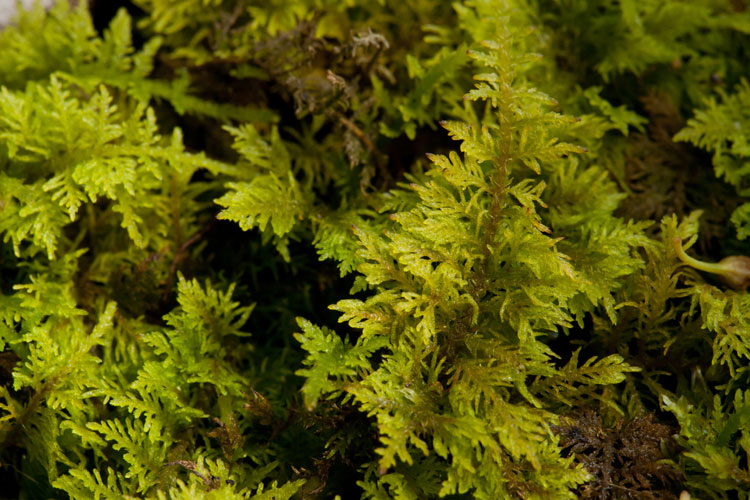
Thuidium delicatulum (fern moss) at the Henry County muck farm. June 19, 2010.

Thuidium delicatulum (fern moss) at the Henry County muck farm. June 19, 2010.
Another moss with a somewhat
widely known common name is "broom moss," Dicranum scoparium
(Dicraniaceae). This robust species occurs as individual upright stems
with very narrow leaves that are "secund," i.e., swept to one side as
if it were a tree in a very strong wind.


Dicranum scoparium (broom moss) at
the Henry County muck farm. June 19, 2010.
A moss that should have a widely known common
name, but, alas, doesn't, is the very distinctive genus Fissidens (Fissidentaceae). The
leaves of Fissidens
are inserted in two distinct rows directly across from one another,
making it very flat. Moreover, the upper base of each leaf is split
lengthwise, and clasps the base of the leaf just above it, an
arrangement that is called "equitant" because the orientation is
similar to the manner in which a rides sits upon a horse (except that
it's upside-down, which is what would probably happen if I ever tried
to get on a horse, which is why I wouldn't ever do that). This species
is F. adiantoides (a specific
epithet that means "resembling Adiantum,
maidenhair fern). There's also a trace of a trailing carpet moss with
bent-back leaves, Campylium stellatum
(Amblystegiaceae).

Fissidens adiantoides at the Henry County muck farm. June 19, 2010.

Fissidens adiantoides at the Henry County muck farm. June 19, 2010.
Free Central Placentation!
Soapwort
June 18, 2010. Columbus, Ohio
Soapwort, also called bouncing Bet, Saponaria officinalis, is an Old World member of the Caryophyllaceae, the pink family. According to the Best Book Ever Written --"The New Britton and Brown Illustrated Flora of the Northeastern United States and Adjacent Canada," by Henry A. Gleason (1952, New York Botanical Garden) --the species was in cultivation before it spread to roadsides and waste places. I wonder what is was in cultivation for. The specific epithet "officinalis" indicates that the plant has or had some medcinal purpose. Was it cultivated for medicine, or just because it is pretty. It is pretty pretty. Here is is beautifying the edge of a parking lot in Columbus, Franklin County, Ohio.

Soapwort population in Columbus. June 17, 2010.
The genus name "Saponaria" is from the Latin sapo,
soap, in reference to a mucilaginous juice that the leaves contain,
forming a lather with water. But I wouldn't recommend washing
dishes with it, because the plant is somewhat poisonous.

Soapwort. June 18, 2010. Columbus, Ohio.

Soapwort flowers. June 18, 2010. Columbus, Ohio.
Upper blossom is older, and shows exert styles and withered stamens.
Lower blossom is younger, showing fresh stamens, and style included.

Soapwort. June 18, 2010. Columbus, Ohio.
Soapwort somewhat resembles
various campions and catchflies but the flowers of those genera
have 3 styles (Silene) or 5
styles (Lychnis). Saponaria
flowers have only 2 styles. Some pink family traits seen in the images
above and below are the simple oppositely arranged leaves, and 5-merous
flowers that have sepals fused together, and separate petals with a
distinctly
narrow base ("claw," concealed by the calyx) and expanded blade (the
only part visible). If the flowers below are any
indication, soapwort flowers develop in "protandrous" fashion, with
the stamens maturing before the pistil.

Soapwort flowers. June 18, 2010. Columbus, Ohio.
Upper blossom is older, and shows exert styles and withered stamens.
Lower blossom is younger, showing fresh stamens, and style included.
Another pink family feature,
a bit obscure but nonetheless intriguing, is that the fruits have an
unusual placentation type. "Placentation" refers to the manner in which
the seeds are borne along the inside of the ovary. Here are three
examples from the grocery store, and then, tah-dah! --soapwort.
1. Marginal Placentation. Fruits such as legumes, that are composed of a single modified seed-bearing leaf (megasporophyll), or "carpel," bear their seeds along a line that corresponds to the margin of the leaf that, in highly modified form, encloses the seeds. Such a "unicarpellate" fruit bears its seeds along a line on one inner edge of the ovary. This is barely visible as bulges in the photo below.

Snow pea, showing seeds borne along one row.
1. Marginal Placentation. Fruits such as legumes, that are composed of a single modified seed-bearing leaf (megasporophyll), or "carpel," bear their seeds along a line that corresponds to the margin of the leaf that, in highly modified form, encloses the seeds. Such a "unicarpellate" fruit bears its seeds along a line on one inner edge of the ovary. This is barely visible as bulges in the photo below.

Snow pea, showing seeds borne along one row.
The row along which the pea
seeds are borne is its marginal placenta.

Snow pea split to show marginal placentation.

Snow pea split to show marginal placentation.
2. Axillary (sometimes called
"axile") Placentation. Except
for legumes, unicarpellate pistils are quite uncommon. Most pistils are
"syncarpous," i.e., composed of two or more seed-bearing units
(carpels) fused together. Sometimes the carpels are evident as chambers
of the fruits, or at least ridges or incomplete internal
divisions. It is common for seeds to be produced where the
internal divisions of the carpels come together, or on the
chamber-forming internal walls of the fruit. Here's a cross-section of
a hot pepper, showing this common placentation type, called "axillary
placentation."

Hot pepper split to show axillary placentation.

Hot pepper split to show axillary placentation.
3. Parietal Placentation. A
fairly uncommon placentation type is one where the seeds are borne
along the
inside wall of the ovary. The gourd family (Cucurbitaceae) has this
"parietal placentation." Here's a cucumber split to illustrate the
placentation type (and to make a salad).

Cucumber showing parietal placentation.

Cucumber showing parietal placentation.
4. Saving the best for last,
it's Free Central Placentation!! This uber-uncommon
placentation type is had by soapwort and other members of the
Caryophyllaceae. Here, the ovary has no internal walls, but there is a
central post-like column attached only at the base of the ovary, and
that column is covered with seeds! This condition is called "free
central
placentation." The photo below shows (left) a soapwort flower teased
apart to expose the outside of ovary, topped by its 2 styles, and
(right) a soapwort
fruit split lengthwise to expose the seed-covered central column.
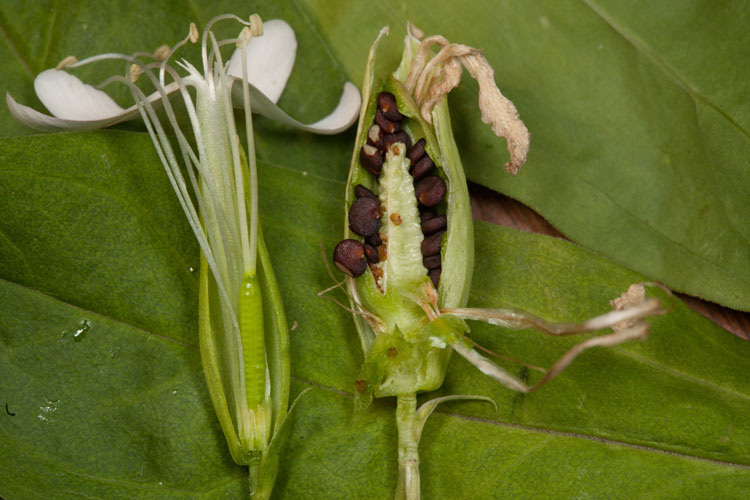
Soapwort flower and fruit details.
Left: flower with overy topped by 2 styles.
Right: fruit split showing free-central placentation.

Soapwort flower and fruit details.
Left: flower with overy topped by 2 styles.
Right: fruit split showing free-central placentation.
A Weed, Not Weed. Knotweed
Polygonum aviculare
June 17, 2010, Killdeer Plains Wildlife Area, Maron County, Ohio
There was a Grateful Dead convention at Killdeer Plains today. One of the participants rolled up the leaves of this little plant in a little piece of paper and was about to set it on fire. I said to him. "That's knotweed." He said, "Oh, far out, man. Thanks. My mistake. What a bummer." Common knotweed, Polygonum aviculare (Polygonaceae, the smartweed family) is an annual herb with repeatedly branched stems. The leaves are small, with a distinctive Polygonaceae feature. The leafstalks have cylindric appendages at their base called "stipules" sheathing the stem. "Polygonum" is from the Greek, meaning "many knees," in reference to the conspicuously jointed stems of many of the species. Hmm. Maybe it was the jointed stems that attracted the deadhead's interest.
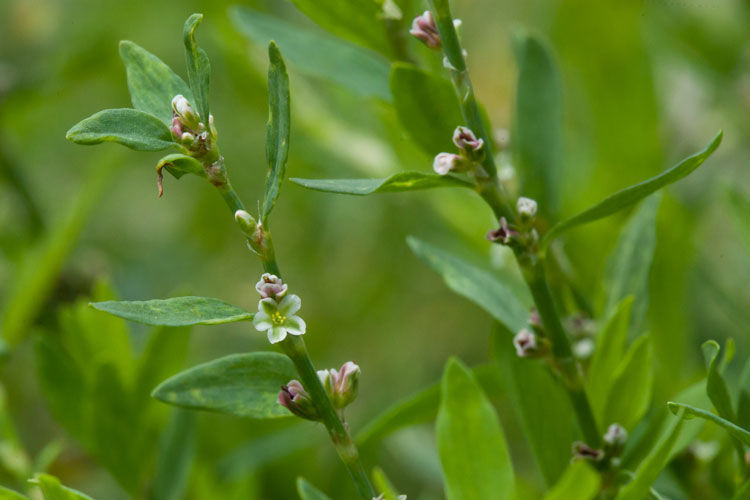
Common knotweed. June 17, 2010. Killdeer Plains. Marion County, Ohio.

Habitat of common knotweed
Killdeer Plains, Marion County, Ohio.
Knotweed flowers lack petals,
but the calyx is pretty pretty. It's composed usually of 5 sepals,
alternating with 5 stamens. The fruit is a dry one-seeded type called
an "achene." Incidentally, buckwheat, Fagopyrum
esculentum,
the achenes of which are a grain-like foodstuff, is a member of this
family. The only other economically important (in a good way)
polygonaceous species is rhubarb. (Rheum
rhaponticum).
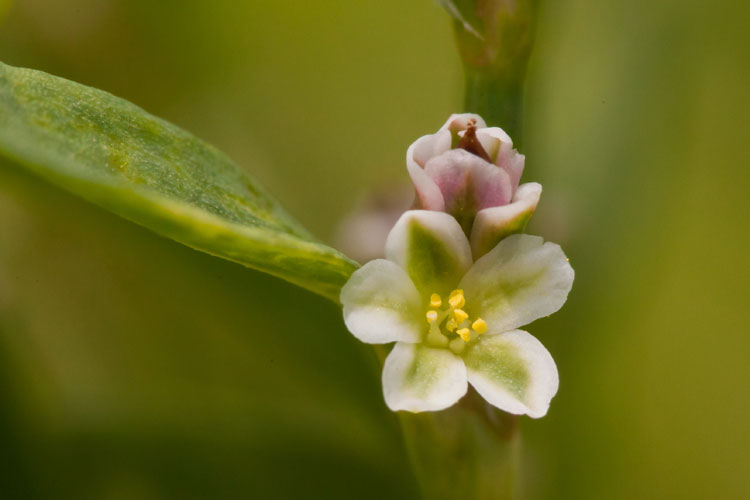
Common knotweed flower. June 17, 2010. Marion County, Ohio.
The 4th Red Flower
Round-leaved catchfly
June 16, 2010. Deep Woods Preserve, Hocking County, Ohio.
A few years ago somebody told
me there are just four pure red Ohio native wildflowers. Is that true?
I
hope so, because if it is, today I snapped a picture that makes my
scrap-book complete, and further cements my eternal gratitude to the
Canon Corporation for making a camera that produces respectable images
under the low light conditions of Deep Woods' deep woods.
This is it: round-leaved catchfly, Silene rotundifolia, a woodland herb in the pink family (Caryophyllaceae) with a fidelity to rocky cliffs and banks. A southern Appalachian species at the northern edge of its range here in southern Ohio, it is a weak-stemmed, decumbent plant with 5-8 pairs of broadly lance-shaped to nearly round leaves. Here at Deep Woods it grows on, and at the rocky talus base of, a sandstone cliff in a hardwood forest part of the preserve. Round-leaved catchfly is potentially threatened in Ohio, known from only 4 counties.
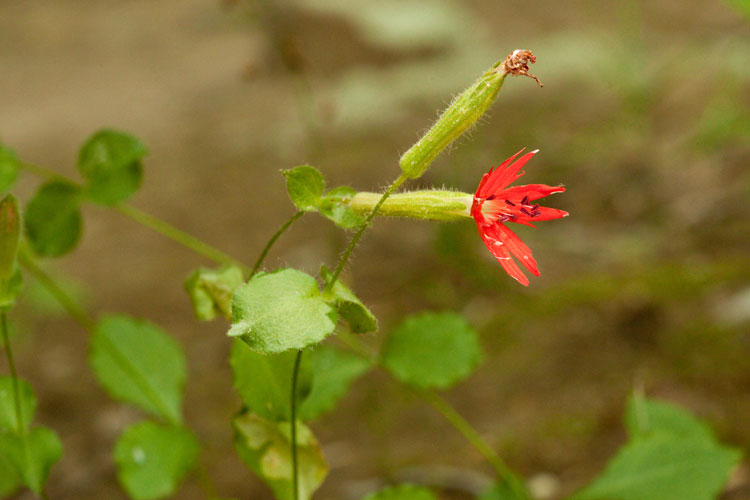
Round-leaved catchfly at Deep Woods. June 16, 2010.
This is it: round-leaved catchfly, Silene rotundifolia, a woodland herb in the pink family (Caryophyllaceae) with a fidelity to rocky cliffs and banks. A southern Appalachian species at the northern edge of its range here in southern Ohio, it is a weak-stemmed, decumbent plant with 5-8 pairs of broadly lance-shaped to nearly round leaves. Here at Deep Woods it grows on, and at the rocky talus base of, a sandstone cliff in a hardwood forest part of the preserve. Round-leaved catchfly is potentially threatened in Ohio, known from only 4 counties.

Round-leaved catchfly at Deep Woods. June 16, 2010.
On an unidentified leaf quite
near the catchfly are some other life-forms, the photographing of which
also
benefited from a high-ISO camera setting. This is a pretty pair of
net-winged beetles (family Lycidae) that appear to be Calopteron reticulatum, identified
using the superb "Kaufman Field Guide to the Insects of North America,"
by Eric Eaton and Ken Kaufman. The authors note that these beetles are
"usually seen sitting on leaves or flying slowly through forests at
dusk." They also tell us that larvae occur in decaying wood or crawling
on the forest floor.

But I digress; back to the red flowers. Two other red Ohio flowers are also members of the genus Silene. One of these is also a woodland wildflower, but more common and wide-ranging than S. rotundifolia: fire pink, Silene virginica. Compared to round-leaved catchfly, fire pink has a more upright growth form, and fewer pairs of leaves, which are narrowly oblanceolate (backwards lance-shaped). Here's fire pink as it appeared almost exactly one year ago in a rich woods in Marion County, situated in the Northwestern Till Plains bio-region of the state.

Fire Pink at Myer's Woods Preserve Marion County. June 14, 2009.

But I digress; back to the red flowers. Two other red Ohio flowers are also members of the genus Silene. One of these is also a woodland wildflower, but more common and wide-ranging than S. rotundifolia: fire pink, Silene virginica. Compared to round-leaved catchfly, fire pink has a more upright growth form, and fewer pairs of leaves, which are narrowly oblanceolate (backwards lance-shaped). Here's fire pink as it appeared almost exactly one year ago in a rich woods in Marion County, situated in the Northwestern Till Plains bio-region of the state.

Fire Pink at Myer's Woods Preserve Marion County. June 14, 2009.
The third scarlet Silene is another rare species, a
prairie wildflower called royal catchfly, Silene regia. Royal catchfly is threatened
in Ohio, which some people find surprising in light of the fact
that it has been found in some fairly disturbed roadside sites, and
easily also thrives in cultivation and prairie restorations. The photo
below was
taken at the restored prairie on the OSU-Marion campus.

Royal catchfly at the OSU-Marion's Larry R. Yoder Prairie. July 23, 2007.

Royal catchfly at the OSU-Marion's Larry R. Yoder Prairie. July 23, 2007.
The 4th member of the crimson
quartet is, of course, the famous cardinal flower, Lobelia cardinalis (Campanulaceae,
the bellwort family). This much-loved wetland herb occurs at Deep Woods
Preserve, where this picture was taken during August of last year in
wet soil along a bank of the creek that bisects the property.


Cardinal flower at Deep
Woods. August 16, 2009.
The genus Lobelia displays several "derived,"
i.e., evolutionarily advanced, floral traits: an inferior ovary;
bilateral
rather than radial symmetry, and; fusion not only of the petals with
one another, but also fusion of the anthers with the terminal half of
the filaments. While we might have to wait a few weeks to see cardinal
flower here, a different lovely lobelia in flower today. This is a
meadow
and prairie species called pale-spike lobelia, Lobelia spicata, fairly common in
the open meadow where, earlier today, we saw cow-wheat and jelly baby
(see below).

Pale-spike lobelia at Deep Woods Preserve, Hocking County,Ohio.

Pale-spike lobelia at Deep Woods Preserve, Hocking County,Ohio.
A few other plants caught our
eyes on this beautiful midsummer day. The top of a large sandstone
boulder in the woods is the home of a thriving stand of rock skullcap, Scutellara saxatilis.
The skullcap genus is one of the more easily recognized ones within the
mint family, as the calyx bears a distinctive upright protuberance on
its upper edge. Like round-leaved catchfly, this is a species chiefly
of the Applachians, at a northern boundary of its range in
south-central Ohio.

Rock skullcap at Deep Woods. June 16, 2010.

Rock skullcap at Deep Woods. June 16, 2010.
In areas of the forest where
eastern hemlock predominates, the soil is rich in organic humus (not to
be confused with organic humous;
I tried the soil on a piece of pita bread and it wasn't very tasty!).
Here, an
especially robust leafy liverwort covers soil, rocks, logs and tree
bases. This is Bazzania trilobata
(family Lepidoziaceae). Bazzania
leaves are arranged in an "incubous" fashion (incubous, not to be
confused with...oh, never mind). Leaves that are incubous
are shingled in such a way that the upper edge of each leaf overlaps
the base of the next higher leaf along the stem. This arangement is
less common that the opposite form, called "succubous." The leaves of
this Bazzania are prominently
3-lobed at the tip.

Bazzania trilobata (and Dicranum moss) at Deep Woods. June 16, 2010.

Bazzania trilobata (and Dicranum moss) at Deep Woods. June 16, 2010.
Parasites, Hemiparasites, and Myco-heterotrophs, Oh-my!
Cancer-root, cow-wheat, and Indian pipes.
June 16, 2010. Deep Woods Preserve. Hocking County, Ohio.
A group of plant enthusiasts
decided to go on a general purpose midsummer botanical foray to Deep
Woods, a privately owned nature preserve in Hocking County, Ohio. One
of the first plants seen in flower today is Indian pipes, Monotropa uniflora,
in the subfamily Monotropoideae within Ericaceae, the heath family
(formerly placed in its own little family, the Monotropaceae).

Indian pipes in flower. Deep Woods. June 16, 2010.

Indian pipes in flower. Deep Woods. June 16, 2010.
While fully and completely a
flowering plant, because Indian-pipes lacks chlorophyll and is
ghostly white, it is sometimes mistaken foor a fungus. Tom Volk,
on one of his excellent " Fungus of
the Month"
pages (where of course he starts out be explaining this isn't a fungus
at all), cites current research that elucidates the 3-way
relationships, wherein Indian pipes is parasitic on a mushroom-style
basidiomycete fungus that is itself engaged in a mutualistic
mycorrhizal
(i.e., "fungus-root") association with forest trees. This is called
"myco-heterotrophy." Volk cites
research done by Martin Bidartono and Tom Bruns
that show the fungal hosts of members of the Monotropoideae to be quite
specific and, moreover, not shared among co-occuring
monotropoids. The hosts of Monotropa
uniflora are members of the genera Russula and Lactarius.

Flowers of Indian pipes. June 16, 2010. Deep Woods Preserve. Hocking County, Ohio.

Flowers of Indian pipes. June 16, 2010. Deep Woods Preserve. Hocking County, Ohio.
Not far from the pipes, we
did in fact see a Russula
fungus. Nearly
impossible to identify to species, Russula
mushrooms are often colorful, have a brittle stalk that can be snapped
like a piece of chalk, and have widely spaced gills that do not bleed
white when broken. (If the gills do bleed white, then it's probably a Lactarius).

Russula mushroom (and Polytrichum moss) at Deep Woods. June 16, 2010.

Russula mushroom (and Polytrichum moss) at Deep Woods. June 16, 2010.
Speaking of fungi, just a
spore's throw away from this mushroom is an interesting little
mushroom-like non-mushroom fungus called a "jelly baby," Leotia lubrica. Leotia
is an ascomycte, i.e., a member of the class of fungi that produces
spores in microscopic sac-like structures (asci) as opposed to the
club-like ones (basidia) had by mushrooms (basidiomycetes). As most
macroscopic ascomyscetes have a cup-shaped fruiting body, it is a
distinct treat to see this little cap-and-stalk shaped one.

But I digress; let's get back to Monotropa. Ohio's only other monotropoid species is pinesap, Monotropa hypopithys. Looking like a multi-headed Indian-pipes, pipesap tends to occur in the same rich forest habitats as does Indian pipes, but is much less frequent. According to the Bidartono and Bruns (2001) paper cited above, pinesap's fungal hosts are various Tricholoma species. Unbeknownst to us this fine June day, pinesap, unseen, was present and flowering or perhaps just about to come up. A couple of months later a few fruiting pinesap plants will be seen in the immediate vicinity. (I'm so far behind on the web site!)

A glimpse into the future: pinesap (in fruit).
August 7, 2010 at Deep Woods, Hocking County, Ohio.

"Jelly baby" fungus
(and Dicranum moss, and Cladonia lichen) at Deep Woods.
June 16, 2010.
But I digress; let's get back to Monotropa. Ohio's only other monotropoid species is pinesap, Monotropa hypopithys. Looking like a multi-headed Indian-pipes, pipesap tends to occur in the same rich forest habitats as does Indian pipes, but is much less frequent. According to the Bidartono and Bruns (2001) paper cited above, pinesap's fungal hosts are various Tricholoma species. Unbeknownst to us this fine June day, pinesap, unseen, was present and flowering or perhaps just about to come up. A couple of months later a few fruiting pinesap plants will be seen in the immediate vicinity. (I'm so far behind on the web site!)

A glimpse into the future: pinesap (in fruit).
August 7, 2010 at Deep Woods, Hocking County, Ohio.
Growing in a shady spot at
the edge of the glade-like meadow where we did much of our botanizing,
in a dense bed of Polytrichum
and Dicranum
mosses is a more typical representative of the heath family. This is a
very
low-growing trailing plant that, being woody, is technically a shrub
even though it just looks like a wildflower: teaberry, Gaultheria procumbens. Having as
distinctive oil wintergreen flavor, teaberry is delightful to
nibble on.

Teaberry at Deep Woods. June 16, 2010.
In this open meadow where the soil is thin and dry, there is another wildlflower that may be a bit less self-sufficient than we expect plants to be. This is cow-wheat, Melampyrum lineare, in the Orobancaceae (broomrape family), to which it was recently transferred from the Scrophulariaceae (figwort family) by somebody who didn't much like it and noticed that "broomrape" is an even skeezier name than "figwort." Cow-wheat is a "hemiparasite," meaning that it is in fact green and photosynthetic, yet derives some of its nutrition, perhaps only some of the time, as a direct root-parasite on other plants (sans fungal intervention). It must have taken a keen eye (and some digging) to have originally discerned this, because cow-wheat looks for all the world like a regular little old wildflower, with nothing in the least parasiticey (ahh, no spell checker in Kompopzer, no wiggly lines...freeeeeedom, yay!!) about it.

Cow-wheat at Deep Woods. June 16, 2010.

Teaberry at Deep Woods. June 16, 2010.
In this open meadow where the soil is thin and dry, there is another wildlflower that may be a bit less self-sufficient than we expect plants to be. This is cow-wheat, Melampyrum lineare, in the Orobancaceae (broomrape family), to which it was recently transferred from the Scrophulariaceae (figwort family) by somebody who didn't much like it and noticed that "broomrape" is an even skeezier name than "figwort." Cow-wheat is a "hemiparasite," meaning that it is in fact green and photosynthetic, yet derives some of its nutrition, perhaps only some of the time, as a direct root-parasite on other plants (sans fungal intervention). It must have taken a keen eye (and some digging) to have originally discerned this, because cow-wheat looks for all the world like a regular little old wildflower, with nothing in the least parasiticey (ahh, no spell checker in Kompopzer, no wiggly lines...freeeeeedom, yay!!) about it.

Cow-wheat at Deep Woods. June 16, 2010.
Deep in the woods, another
member of the Orobancaceae is quite abundant. This is cancer-root, Conopholis americana. Cancer-root
is a "holoparasite," i.e., it lacks chlorophyll and is wholly dependent
on its host for nutrients and water. Conopholis
directly connects to oaks and beech by means of underground
attachment organs called "haustoria" that tap into their roots.

